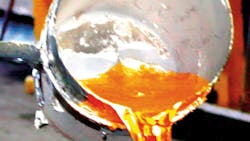Reuland Electric, a manufacturer of AC electric motors of multiple different designs and configurations, has installed three new gas-fired crucible furnaces for its aluminum foundry in City of Industry, CA. Reuland’s motors are supplied for various applications in aerospace operations, crane-and-hoist systems, and for low-temperature operations, like food processors used in freezers, or in cryogenic processes.
The three Thermtronix Model GS900, solid-state gas-fired stationary furnaces were installed there late last year, a source indicated. Each vessel has a capacity of 900 lb. of molten metal.
Reuland’s foundry is a 16,000-sq.ft. operation that pours aluminum 319, 356, A356 and additional specialty alloys on request. The company also has precision CNC machining capability, including turning large parts, vertical milling, cylindrical grinding, vertical grinding, and honing.
Other operations on the 10-acre site include anodizing, heat-treating, and inspection.
Reuland’s Machining Services Division has earned ISO 9001:2008 certification.
The foundry was established in 1948 to support the Reuland Electric Motor Company. Now, the company has base of customers for castings, other than its own motor manufacturing operations. It produces prototype castings, as well as long and short runs, and notes it will produce castings from supplied patterns, prints, computer files, or existing castings.
The new furnaces were installed as a cost-saving measure. "We crunched the numbers and realized we were spending more per year to run the old reverb furnaces than it cost to purchase and operate new ones," stated plant manager Don Trimmer. "We opted for the 900-lb high-efficiency furnaces to meet demand for increased capacity, improve air quality, and decrease our carbon footprint.
“We have lowered our scrap rate to 1% with the new furnaces by exacting precision metal treatments on each melt and maintaining tight sand control," Trimmer emphasized.
About the Author
Robert Brooks
Content Director
Robert Brooks has been a business-to-business reporter, writer, editor, and columnist for more than 20 years, specializing in the primary metal and basic manufacturing industries. His work has covered a wide range of topics, including process technology, resource development, material selection, product design, workforce development, and industrial market strategies, among others.
